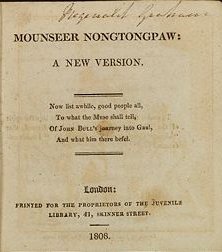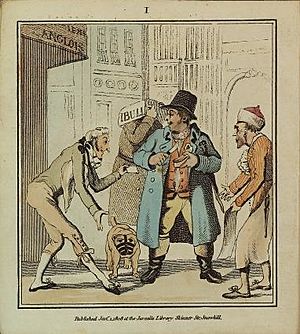Mounseer Nongtongpaw facts for kids
Mounseer Nongtongpaw is a funny poem from 1808. Many people believe it was written by Mary Shelley when she was a child. She later became a famous writer, known for Frankenstein. The poem is based on a popular song by an entertainer named Charles Dibdin. It was published in a collection for young readers called Juvenile Library, created by the philosopher William Godwin. The poem uses humor to show differences between French and English people. It especially makes fun of an English character called John Bull because he can't understand French. William Mulready, a friend of Godwin, drew the pictures for the poem.
Contents
How the Poem Was Published
Mounseer Nongtongpaw was first published in 1808. It was part of the Juvenile Library series. This series was created by William Godwin's publishing company, M. J. Godwin.
The poem was printed in England in 1811, 1812, 1823, and 1830. It was also printed in Philadelphia, USA, in 1814 and around 1824. The first edition had pictures drawn by William Mulready. He was an artist supported by Godwin. Some people think that Mary Shelley might have written some verses to match pictures that were already drawn. The old pictures from the book can be seen in a book called Nursery Companion by Iona and Peter Opie.
What the Poem is About
Mounseer Nongtongpaw is based on a popular song from 1796. The song was by an entertainer named Charles Dibdin. His original song made fun of English and French stereotypes. It especially poked fun at an English character named John Bull because he refused to learn French.
John Bull's French Adventure
In the story, John Bull asks many questions while traveling in France. But he always gets the same answer: "Monsieur, je vous n'entends pas." This means "Sir, I don't understand you" in French. John Bull misunderstands this phrase. He thinks it's the name of a person: "Mounseer Nongtongpaw."
He visits famous places like the Palais-Royal and Palace of Versailles. He also sees a beautiful woman. Each time he asks who owns them, he hears "Nongtongpaw." So, he starts to believe that all these amazing things belong to this mysterious person.
Later, John Bull sees a funeral. When he asks who died, he gets the same "Nongtongpaw" answer. He then sadly concludes that even all of Nongtongpaw's wealth couldn't save him from death.
More Funny Events
The poem Mounseer Nongtongpaw adds more funny parts to Dibdin's original song. It tells new stories in shorter, four-line verses. For example, John Bull asks about a big feast at a tavern. He also asks about a shepherd's sheep, a fancy coach, and even a hot-air balloon. Each time, he gets the same confusing answer.
Here is an example from the poem:
[John Bull] ask'd who gave so fine a feast,
As fine as e'er he saw;
The landlord, shrugging at his guest,
Said "Je vous n'entends pas."
"Oh! MOUNSEER NONGTONGPAW!" said he:
"Well, he's a wealthy man,
"And seems dispos'd, from all I see,
"To do what good he can.
"A table set in such a style
"Holds forth a welcome sign," —
And added with an eager smile,
"With NONGTONGPAW I'll dine."
Why This Poem is Important
Mounseer Nongtongpaw is seen as the start of Mary Shelley's writing career where she worked with others. We don't know exactly what she wrote. But her ideas helped inspire the final published poem.
See also
 In Spanish: Mounseer Nongtongpaw para niños
In Spanish: Mounseer Nongtongpaw para niños



